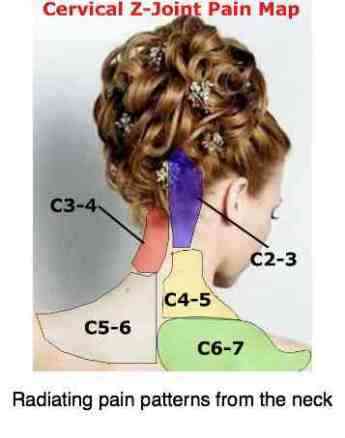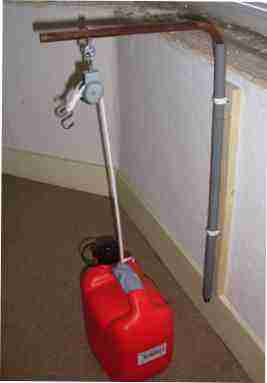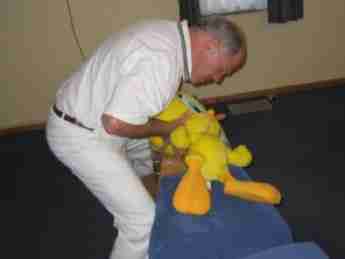Cervical Facet Syndrome
Cervical facet syndrome is a common complaint after whiplash and other injuries such as diving into shallow water or falling off a horse onto the head.
This page was last updated by Dr Barrie Lewis on 1 July, 2019.

This neck pain faces the chiropractic physician on a daily basis.
Neck pain, headache and, less commonly, a deep numbness or tingling radiating down the arm, but more frequently to the region between the shoulders.
The cause is quite simply, trauma, and sometimes poor posture; for example sleeping on your stomach.
For years medicine has been in denial that whiplash, and other related trauma, can and frequently does cause injury to the various tissues in the neck.
In a 10-year follow up study after whiplash, only 12 percent of the victims reported that they had absolutely no symptoms and had healed completely.
In another study reported in Spine, a prominent medical journal, fully 60 percent of whiplash patients were found to be suffering from a cervical facet syndrome.
There is oodles of research now on whiplash, done by a whole range of specialists, chiropractic, orthopedic, neurological and radiological confirming the importance of the cervical facet syndrome.
- Read more about WHIPLASH RESEARCH …
- Read more … SOFT TISSUE INJURIES OF THE NECK ...
Cervical Facet Syndrome
Cervical facet syndrome faces the chiropractor on a daily basis; headache, neck and radiating arm pain are the result.
The vertebrae, the ligaments, the muscles, the nerves, the discs and the facets (aka Z-joints) are all vulnerable to whiplash. Other more nebulous tissues too, like the fascia, of course the cord itself, and the blood vessels. Now there is overwhelming evidence that whiplash does cause permanent injury, and the cervical facet syndrome is one of the most traumatised tissues.

SYMPTOMS
The facet joints in the neck have quite different shapes and orientations depending on their location, so the presentation varies quite dramatically according to which facet is involved. Very broadly, and frankly this is an over-simplification, we can divide the cervical facet syndrome into four different types:
Atlanto occipital joint
The atlanto occipital joint is found between the head and the first bone in the neck; cervical facet syndrome can occur there too.
These two joints, right and left, lie between the base of the skull known as the occiput, and the first bone in the neck, called the atlas; C0-C1.
Hence the name atlanto occipital joint. It is at this point that nodding movements of the skull on the neck occurs; small up and down movements, adjusting the head position in relation to the monitor in front of you, for example.
Subluxation of these joints causes a deep ache at the very top of the neck, often causing severe headaches. A large artery supplying the base of the brain winds it's way around this area.
Subluxations of this joint can cause widely differing symptoms such as vertigo and loss of balance. Medically this is often causes a condition called benign positional paroxysmal vertigo, and sometimes Meniere's disease, if it there is associated deafness and ringing in the ear.
However, in my experience, Meniere's is often wrongly diagnosed, the cause being either at this joint, or that condition in the inner ear, called BPPV that is very treatable with new techniques called the Epley Maneuver; this is a short course for chiropractors wanting to learn the how to do it.
Google appears to frown on too many links, so phrases in bold, like that above, need to be copied and pasted into the Site Search function in the navigation bar on your left if you want more information.
Atlanto Axial joint anatomy
This atlanto axial joint anatomy is quite different to C0-C1; we are talking C1-C2. It is here that most of the rotation of the neck occurs. Subluxations of the atlas are one of the causes of a severe stiff neck, often associated with headache too; torticollis physical therapy.
For more about the anatomy of the atlas, and the cervical facet syndrome,
Click here. ATLANTO AXIAL JOINT ANATOMY >>
C2-C3

This joint has no specific name (as C3 as no name). However, it is possibly the most commonly subluxated joint in the neck. (Chiros will argue vociferously about that!) It too can cause headaches and a very stiff neck called a Torticollis. Pain!
See those 'facet joints'? They are lined with glistening white hyaline cartilage. When healthy it's very hard but, because it has no blood supply, it's very dependent on certain physiological factors for health and restoration after injury. The alternative is arthritis, stiffness and pain. Read more ...
Chiropractic help for lower neck and arm pain(C4-T1)
Facets in the mid-to-low cervical spine again are rather different in orientation and also, by virtue of the fact that the nerves emerging from the region supply the shoulder and arm, the Cervical Facet Syndrome presents rather differently.
Thus headache is less of a feature in this region. Rather, the fixations cause stiffness of the neck, and associated tightness and pain in the shoulder muscles.
Whiplash research
Just adjacent to the facets, small joints often injured in MVAs and diving accidents. Known as the Whiplash and the JOINTS of LUSCHKA, they also contribute to radiating pain down the arm; whiplash research makes fascinating reading.
- More about UncoVertebral Joint Luschka ...
- Whiplash research is where much cervical facet syndrome is focused.
Testing for a pinched nerve
A frank pinched nerve in the lower neck is tested using the Upper Limb Tension Test ... arm pain, repetitive strain injury of the arm, especially at the computer (mouse arm) usually have a neurogenic origin.
Jaw joint pain
Because the sensory Trigeminal nucleus of the nerve supplying the jaw joint is found in the upper neck, in the region C1-C3, sensory information from the cervical facets feeding into that same nucleus, the cervical facet syndrome and jaw joint pain often go hand in hand.
Between them, the cervical facets and the TMJs are the major cause of blinding Migraine headaches, though it must be recognised there are many causes of migraine. For more about headache in general, and the association between the TMJ and migraine, click here.
Read more about HEADACHE CHIROPRACTIC ...Arm pain
The whole arm becomes vulnerable.
The nerves emerging from this region supply the shoulder and arm. Should there be nerve involvement then the pain, tingling and numbness may spread into the limb, causing obscure arm pain and making you will be vulnerable to shoulder pain, conditions such as

Take note of the first rib in the diagram above. A fixated rib is the most common cause of the so called Thoracic Outlet Syndrome which can affect the artery supplying the arm, and the nerves. Working with your hands above your head, as in hanging the washing, or using a drill above shoulder level, makes your arm tired very quickly.
To understand the low cervical facet syndrome properly you need to have some grasp of the low cervical facet anatomy.
The the basis of your arm pain be a pinched or irritated nerve in the neck? The basic test for a pinched nerve in the neck is known as the Upper Limb Tension Test ...
Deep upper back pain
Deep upper back pain is one of the most trying and difficult conditions in our clinics; I also get a vast number of letters from readers complaining of an unresolved condition.
It's simply a complex area, but part of the reason is that it may be caused by a cervical facet syndrome; the rhomboids and levator scapular muscles are supplied by C5.
But deep upper back pain can also be caused from a rib, or even lung condition, and many others; it certainly tests a doctor's diagnostic ability, as well as his or her manipulative skills.
Which movements provoked the pain?
Chiropractic help
Mostly, though not always, the cervical facet syndrome is bread and butter for chiropractic help. Only rarely are there complications, such as after recent trauma or in very degenerate joints. On any average day, s/he will be treating numerous people with this condition.
The treatment will involve soft-tissue work of any associated muscle spasm, perhaps manual traction, and then manipulation. This manipulation is not ordinarily particularly painful, but may be a little unnerving at the first couple Chiropractic help treatments.
The cartilage lining these facet joints is very dependent on normal movement of the joint for their nutrition. Jamming of the joints that is not attended to leads to what is called Immobilisation Arthritis ...
- Read more about Early symptoms of ARTHRITIS …
- Neck pain anatomy ...
- Read more about NECK PAIN …
- The Standard Diagnostic Test for this condition. CERVICAL COMPRESSION TEST ... A fun page; don't miss it!
To find links to the topics in bold copy and paste them into the site search function in the navigation bar on your left.
There is admittedly nothing simple about chiropractic help treatment
of the neck. Like good surgery, it's a mixture of science and art. The
art of a gentle yet effective manipulation, that does not cause undue
pain or stress on the spine is something that takes years to learn.
Read more about CHIROPRACTIC NECK PAIN TREATMENT …
Iatrogenic Illness
It is acknowledged that there is some risk associated with all treatment, including Chiropractic.
- Read more about IATROGENIC ILLNESS …
- CHIROPRACTIC IATROGENIC ILLNESS ..
Do you have a problem that is not getting better?
Are you looking for a different slant on your pain?
Do you want to pose a question?
Sleeping on your tum
The cartilage of the joints of the spine do not have a direct blood supply. Rather they are dependent for their nutrition on fluids bathing the tissues.
During the night, free from gravity, these fluids are refreshed, infusing the spine. You literally get taller. That's one of the reasons why we are all stiff in the morning, and need to stretch. Take a hint from your cat.
Then, during the day, with the weight of gravity, the fluids are squeezed out again, taking noxious waste products with them.
This is a very important process for the normal nutrition of the
cartilage. Starved of oxygen and nutrients, and the build up of waste
products of metabolism, the joint tissue very quickly begins to degenerate and become arthritic; within 13
hours in white mice.
Sleeping on your tum, with your head turned all night, keeps the joints under tension, stopping this nutritional pump from feeding the tissues of the neck adequately. The result is pain and early arthritis of the spine.
From an early age, do not put your children to sleep on their tums, as advocated by the famous Dr Spock.
There is an increase in
cot deaths, and they will get into a life-long habit of sleeping on the
stomach that is difficult to break.
Prevention
Prolonged flexion of the neck puts the cervical facets and muscles under arduous strain. Every home and office should have one of these. It will pay for itself in weeks. Increased productivity, less absenteeism due to headache and visits to the doctor and chiropractor. Fewer mistakes from a drugged worker struggling with a headache.
The Posturite costs around 100 pounds. Click on the graphic for details ...wonderful for the Cervical Facet Syndrome. My wife, a teacher, wouldn't be without her Posturite. She uses it EVERY day.

All sensible exercise will benefit your neck. You might like to try some of these STIFF NECK EXERCISES FOR NECK PAIN ...
Think too about your bedside lights; having to crane your neck to get sufficient direct light is certainly one cause of neck pain.
Unexplained infertility
There are few stranger occurrences at the chiropractic coalface than the woman who, coming for cervical facet syndrome care, yet experiencing the inner pain of unexplained infertility, and suddenly becoming pregnant, after years of trying.
To my knowledge no trials have ever been attempted, it's just too ludicrous, yet every chiropractor can regale you with anecdotes.
The explanation is certainly not obvious; perhaps it just has to do with the release from chronic pain. Straight chiropractors would not be phased in the slightest; subluxations do far more than cause pain; and so they do.
Cervical myelopathy
Whether due to severe injury, and thus with the best will in the world this was going to happen anyway, or to neglect, the Cervical Facet Syndrome can sometimes lead to such severe degeneration that it can effect the spinal cord, and ultimately cause weakness and disability in the legs. A standard procedure is the Ten Second Step Test.
- Read more ... Ten second step test ....
- Symptoms of cervical stenosis ...
Self manipulation
There are few more damaging things for the spine than self manipulation. And I'm not being a humbug, suggesting you pay your chiropractor when you could be treating yourself for free.
During a chiropractic manipulation, your doctor will distract the joint so there is no cartilage on cartilage contact during the procedure. Self manipulators can't do that, and trauma occurs every time to you click your own neck; or any joint for that matter.
Add to that you cannot do it properly, so you gain very temporary relief. Self manipulators end up popping their own necks half a dozen or more times a day; we think that a joint shouldn't be manipulated more than perhaps twenty five times a year. Self manipulators achieve that in a week; it's severely traumatic for the spine.
A severely damaged nerve root and awful pain radiating down the arm will be the result. Prove me wrong! I've seen it so often.
HOME TRACTION UNIT

HOME TRACTION UNIT ... make it yourself.
USEFUL LINKS @ CERVICAL FACET SYNDROME
- Neck exercises and a simple test for neck strength. JULL'S TEST ...
- Whiplash Chiropractic ... always consult a chiropractor after an accident to prevent Immobilisation Arthritis.
- The joint at the base of the skull can be the cause of severe headaches. ATLANTO OCCIPITAL JOINT ...
Did you find this page useful? Then perhaps forward it to a suffering friend. Better still, Tweet or Face Book it.

